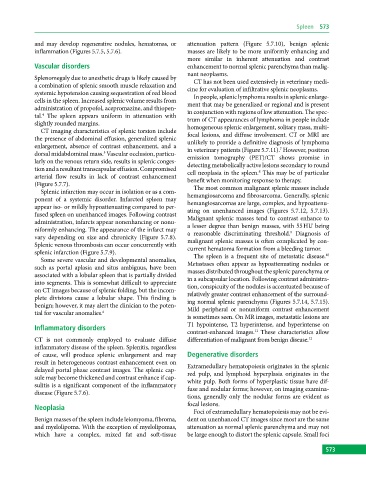Page 583 - Atlas of Small Animal CT and MRI
P. 583
Spleen 573
and may develop regenerative nodules, hematomas, or attenuation pattern (Figure 5.7.10), benign splenic
inflammation (Figures 5.7.5, 5.7.6). masses are likely to be more uniformly enhancing and
more similar in inherent attenuation and contrast
Vascular disorders enhancement to normal splenic parenchyma than malig
nant neoplasms.
Splenomegaly due to anesthetic drugs is likely caused by CT has not been used extensively in veterinary medi
a combination of splenic smooth muscle relaxation and cine for evaluation of infiltrative splenic neoplasms.
systemic hypotension causing sequestration of red blood In people, splenic lymphoma results in splenic enlarge
cells in the spleen. Increased splenic volume results from ment that may be generalized or regional and is present
administration of propofol, acepromazine, and thiopen in conjunction with regions of low attenuation. The spec
tal. The spleen appears uniform in attenuation with trum of CT appearances of lymphoma in people include
4
slightly rounded margins. homogeneous splenic enlargement, solitary mass, multi
CT imaging characteristics of splenic torsion include focal lesions, and diffuse involvement. CT or MRI are
the presence of abdominal effusion, generalized splenic unlikely to provide a definitive diagnosis of lymphoma
enlargement, absence of contrast enhancement, and a in veterinary patients (Figure 5.7.11). However, positron
7
dorsal midabdominal mass. Vascular occlusion, particu emission tomography (PET)/CT shows promise in
5
larly on the venous return side, results in splenic conges detecting metabolically active lesions secondary to round
tion and a resultant transcapsular effusion. Compromised cell neoplasia in the spleen. This may be of particular
8
arterial flow results in lack of contrast enhancement benefit when monitoring response to therapy.
(Figure 5.7.7). The most common malignant splenic masses include
Splenic infarction may occur in isolation or as a com hemangiosarcoma and fibrosarcoma. Generally, splenic
ponent of a systemic disorder. Infarcted spleen may hemangiosarcomas are large, complex, and hypoattenu
appear iso‐ or mildly hypoattenuating compared to per ating on unenhanced images (Figures 5.7.12, 5.7.13).
fused spleen on unenhanced images. Following contrast Malignant splenic masses tend to contrast enhance to
administration, infarcts appear nonenhancing or nonu a lesser degree than benign masses, with 55 HU being
niformly enhancing. The appearance of the infarct may a reasonable discriminating threshold. Diagnosis of
9
vary depending on size and chronicity (Figure 5.7.8). malignant splenic masses is often complicated by con
Splenic venous thrombosis can occur concurrently with current hematoma formation from a bleeding tumor.
splenic infarction (Figure 5.7.9). The spleen is a frequent site of metastatic disease.
10
Some severe vascular and developmental anomalies,
such as portal aplasia and situs ambiguus, have been Metastases often appear as hypoattenuating nodules or
masses distributed throughout the splenic parenchyma or
associated with a lobular spleen that is partially divided in a subcapsular location. Following contrast administra
into segments. This is somewhat difficult to appreciate tion, conspicuity of the nodules is accentuated because of
on CT images because of splenic folding, but the incom relatively greater contrast enhancement of the surround
plete divisions cause a lobular shape. This finding is ing normal splenic parenchyma (Figures 5.7.14, 5.7.15).
benign; however, it may alert the clinician to the poten Mild peripheral or nonuniform contrast enhancement
tial for vascular anomalies. 6
is sometimes seen. On MR images, metastatic lesions are
T1 hypointense, T2 hyperintense, and hyperintense on
Inflammatory disorders
contrast‐enhanced images. These characteristics allow
11
CT is not commonly employed to evaluate diffuse differentiation of malignant from benign disease. 12
inflammatory disease of the spleen. Splenitis, regardless
of cause, will produce splenic enlargement and may Degenerative disorders
result in heterogeneous contrast enhancement even on
delayed portal phase contrast images. The splenic cap Extramedullary hematopoiesis originates in the splenic
red pulp, and lymphoid hyperplasia originates in the
sule may become thickened and contrast enhance if cap
sulitis is a significant component of the inflammatory white pulp. Both forms of hyperplastic tissue have dif
fuse and nodular forms; however, on imaging examina
disease (Figure 5.7.6).
tions, generally only the nodular forms are evident as
Neoplasia focal lesions.
Foci of extramedullary hematopoiesis may not be evi
Benign masses of the spleen include leiomyoma, fibroma, dent on unenhanced CT images since most are the same
and myelolipoma. With the exception of myelolipomas, attenuation as normal splenic parenchyma and may not
which have a complex, mixed fat and soft‐tissue be large enough to distort the splenic capsule. Small foci
573
572 573

